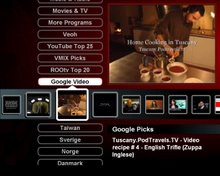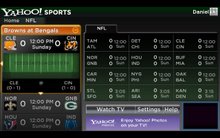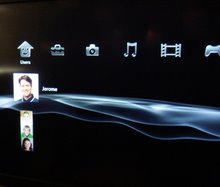Solutions: Active-TV technology pushes the software support burden onto a networked PC, so as to mostly eliminate the cost and maintenance burden at each TV. Synchromesh Computing has benchmarked the load the TVs place on the supporting PC. Processing TV-web requires the support of complex software, but the processor burden is typical very small.
Behind the scene: As TV System-on-Chip (Soc) devices offer increasing support for advanced video codecs, it is clear that the most restrictive component of an active-TV technology home-network is the broadband service to the home. Currently, the PC can be used to transcode non-native video into a format decodable at the TV. Support for this feature appears to be the biggest processor burden placed on the supporting PC.
Synchromesh Computing used a system of up to 5 D-Link DSM-520 Digital Media Adapters (DMA). They were connected by wire to a home router. The home PC or laptop was also connected to the router, but by either a wire or 802.11g wireless connection. Each of the active-TV enabled TVs was simultaneously viewing YouTube video. Synchromesh told me that they did not think wirelessly connecting all of the DSM-520s would effect YouTube viewing at the TV. They did not test a completely wireless network as their primary interest was in determining the load on the home PC or laptop rather than the home network.
Three different PC systems were used for the test (see table below). These supported greatly different computational power levels.

The test was to determine if the PC had the computational power to support all of the 5 TVs, or some reduced number. Technically it is possible to support more than 5 TVs, but an upper limit of 5 seems adequate for home use.
The chart below shows the number of active-TV technology clients (D-link DSM-520) supported by a PC using Windows XP, while the PC assisting the TVs is also being used simultaneously to surf the web and view YouTube video.
( © Synchromesh Computing )
The chart below shows the number of active-TV technology clients (D-link DSM-520) supported by a PC using Windows Vista, while the PC is assisting the TVs and is simultaneously being used to surf the web and view YouTube video.
( © Synchromesh Computing )
The results indicate that a dual-core PC or Laptop computer can support 5 TVs while still being used to browse the web. A single-core low-end PC restricts the number of TVs supported to 1 or 2, depending on the PC operating system on type of home network used.
The use of YouTube video is interesting as it is currently available in Adobe Flash video (FLV) or H.264. Neither of these are natively decoded by the DSM-520. In the benchmark case, the video was accessed in FLV and transcoded to MPEG2. The use of MPEG2 results in relatively high bandwidth consumption but good video quality.
When the internet video is available such that no video transcode is required, then the burden on the PC is obviously dramatically reduced or eliminated in terms of the video trancode load imposed. This will increasingly be the case, but for now, it is good that the PC can ensure that the TV user is not restricted.
But what if the PC user is placing a heavy load of the PC’s CPU, such as running a complex game. How does this limit the TV’s ability to access YouTube? The chart below shows the number of active-TV technology clients (D-link DSM-520) supported by a PC using Windows XP, while the PC assisting the TVs is simultaneously used to play World of Warcraft – a 3D PC game.
( © Synchromesh Computing )
The results indicate that when playing a complex game, a low-end dual-core PC is only able to “spare” enough “CPU-cycles” to support 3 or 4 TVs requiring YouTube-quality video transcode. As with the lightly loaded PC tests, a high-end dual core PC is able to support 5 TVs -- even when it is heavily loaded with other activity.
The results are interesting to the engineer. But in practice, unless you have a relatively old or slow PC, the biggest restriction imposed on multiple TV access to internet video is the bandwidth available through the home connection. “Better quality” internet video can use more than 0.7MBps of bandwidth. Supporting 5 channels might require 3.5MBps bandwidth; which is certainly more bandwidth than currently available to many home users in the US. It would be best to first test your ISP bandwidth to determine if it has the capacity to support so much TV-web browsing.
Feedback, corrections and comments welcome. Contact me for more information or support with active-TV technology development.
Daniel Mann











15 comments:
Im loving all the new gadgets of the different companies, the new iphone is amazing, the ipad also incredible, and all with more and more improvements and resolution, with more capacity of storage.
The network and the various statistics looks really good.
Other user's playlists and video collections for future viewing.
Very impressive idea. You innovated a fabulous formula. Nice work.
The results are interesting to the engineer...
For now there is no worry for the video viewing.Because,an active-TV technology pushes the software support burden onto a networked PC, so as to mostly eliminate the cost and maintenance burden at each TV.
Great work . Very nicely written . i am almost impressed .
The PC can be used to transcode non-native video into a format decodable at the TV....
New TV buyers might be prepared to reconfigure their file sever or home network router, once; but they are not willing to maintain TV plug-ins and drivers.
i am glad because when i will buy in near future a TV i can browsing the web, this is cool
I never thought about this before but reading your post today made me think too and hope that your future posts will be as informative as this was.
I am very impressed with the overall presentation of the post.
I have 3 Tvs in my home and i have internet video on all of them. I never had a problem and i think im gonna buy another TV really soon.
I am very impressed with the overall presentation of the post.
Post a Comment